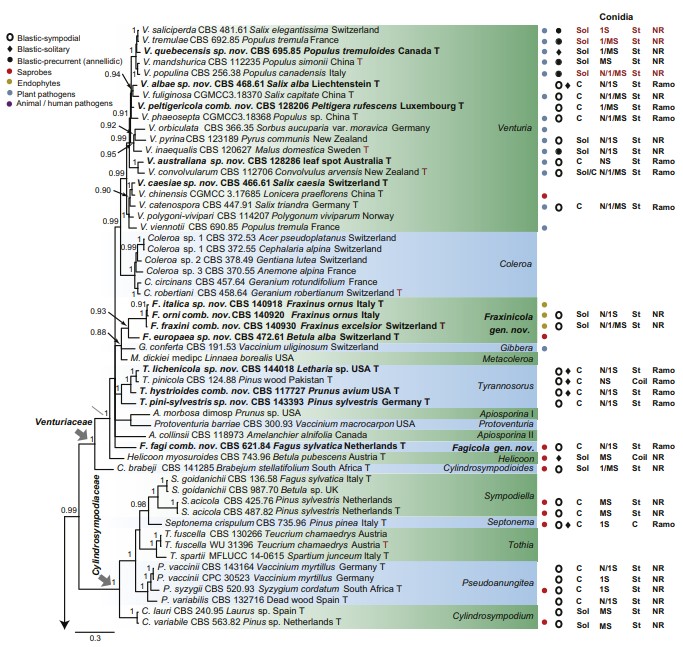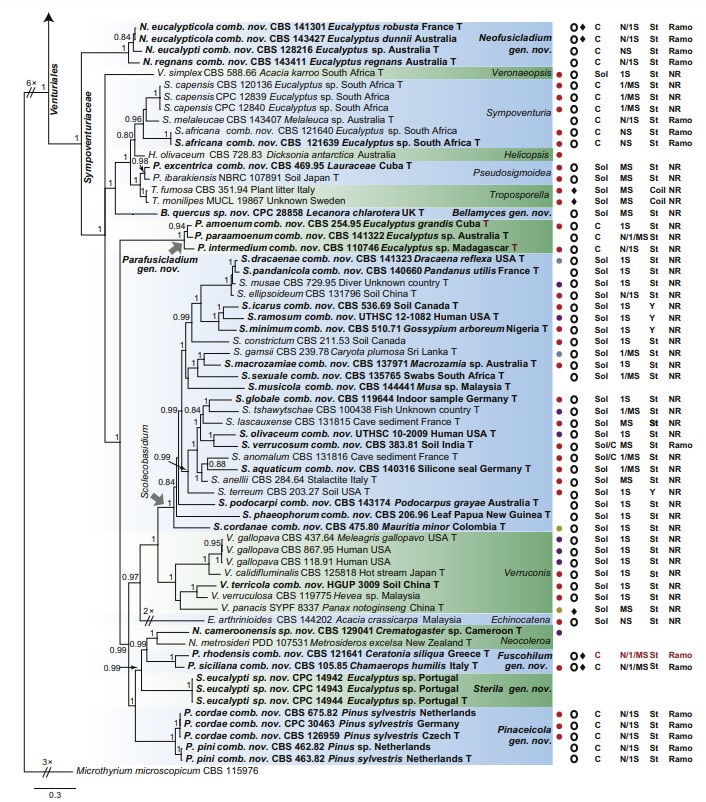Parafusicladium Crous, M. Shen & Y. Zhang ter, gen. nov.
Index Fungorum number: MB831513; Facesoffungi number: FoF 12043
Etymology: Named after Fusicladium, the morphologically most comparable genus. Para means false.
Mycelium consists of pale brown, smooth, branched, septate hyphae. Conidiophores erect, solitary, subcylindrical, brown to dark brown, septate, sometimes thick-walled, smooth, rarely branched below, and sometimes dimorphic. Conidiogenous cells integrated, terminal, rarely lateral, brown, smooth, with several or numerous sympodial denticle-like loci, somewhat thickened and darkened, but not refractive. Conidia sometimes occur in short chains, straight, cylindrical, subcylindrical, subhyaline to pale brown, smooth, guttulate, mostly 1-septate, ends obtusely
rounded; hila somewhat thickened and darkened (adapted from Ho et al. 1999, Crous et al. 2007b, 2016).
Type species: Parafusicladium amoenum (R.F. Casta~neda & Dugan) Crous, M. Shen & Y. Zhang ter
Notes: – The sympodial conidiogenous cells and subcylindrical conidia with somewhat thickened and darkened hila of Parafusicladium point to Sympoventuriaceae. Based on a multigene phylogenetic analysis, it forms a subclade sibling to other genera of Sympoventuriaceae (Fig. 1). Parafusicladium is thus introduced here comprising three species, viz., P. amoenum, P. intermedium and P. paraamoenum.

Fig 1. Consensus phylogram (50 % majority rule) of 691 952 trees resulting from a Bayesian analysis of the combined alignment of ITS, LSU, tef1, tub2 and rpb2 sequences of Venturiales. Bayesian posterior probabilities (PP) > 0.80 are shown at the nodes and the scale bar represents the expected changes per site. Some branches were shortened to facilitate layout. The tree was rooted with Microthyrium microscopicum (CBS 115976). Culture collection numbers, substrates and countries are indicated behind the species names. Those highlighted in bold are new taxa or new combinations proposed in this study, and type strains are marked with “T” (ex-type in black, ex-epitype in red). Relevant morphological characteristics plotted are abbreviated as follows: Sol – conidia solitary, C – conidia in chains, NS – aseptate conidia, 1S – 1-septate conidia, MS – multi- septate conidia (septa ≥ 2), St – straight or slightly curved conidia, Coil – coiled conidia, Y – Y-shaped conidia; Ramo – ramoconidia present, NR – ramoconidia not observed;
? – asexual morphology not available (either from references or from sporulation induced in this study); and morphological characters plotted in red means strains failed to sporulate in this study and plotted values are taken from the original description, observation of this study or related references. Other characteristics are explained in the legend.

Fig 1. (Continued).
Species
